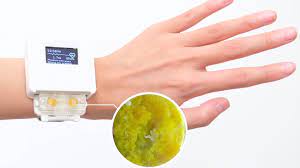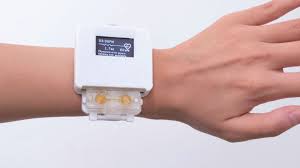Slime mold-powered alive wristwatch. Most individuals spend their days and nights with devices like cellphones, computers, and smartwatches in their pockets, on their wrists, or somewhere else near by.
However, many individuals are ready to throw away or replace their item without giving it much thought when these technologies malfunction or a newer model enters the market. Electronic garbage is the fastest-growing type of waste, with 40 million tons produced annually as a result of its disposability.
Jasmine Lu and Pedro Lopes, researchers at the University of Chicago, pondered whether they might alter that erratic relationship by physically bringing machines to life.
The researchers developed a timepiece that only functions when the electrically conductive single-cell organism known as “slime mold” is in good condition, necessitating the user’s feeding and attention.
They then conducted tests to see how this live item altered the wearer’s attitude toward technology, turning the customary one-way relationship into a cooperative one.
Lu, a graduate student in his fourth year working in assistant professor Pedro Lopes’ Human-Computer Integration Lab, observed that “people were forced to think about their relationship to electronics in a variety of really intriguing ways.”
“People who spoke about their usage of Fitbits, regular smartwatches, or other wearable technology claimed they only used it for that specific reason. And because they had to take care of this equipment, it seemed more like a two-way interaction. Because it was alive, they felt a connection to it that prevented them from just putting it in the closet or throwing it away.”

Lu created and produced the timepieces, which can both tell time and gauge the wearer’s heart rate. The second purpose, however, is reliant on the viability and distinctive qualities of Physarum polycephalum, a kind of slime mold frequently referred to as “the blob” because of its quick growth, toughness, and intriguing maze-solving skills.
The user must frequently feed the creature a solution of water and oats to encourage its growth. The organism is housed in an enclosure on the watch. The heart rate monitor feature is activated when the slime mold crosses over to the other side of the container and creates an electrical connection. In the absence of food, the organism can also go into a dormant stage that allows for a subsequent resuscitation days, months, or even years later.
Making things simpler and faster to use is the driving force behind a lot of human-computer interaction research, according to Lopes. “Jasmine, however, believed that there should be more conflict; you should have to take care of it and feed it each day for the purpose of just having to think about it. So it’s sort of like a study report and an art work.”
Five volunteers wore the timepieces for two weeks in a research that Lu and Lopes conducted after the watches had been constructed. The users took care of the slime mold throughout the first week before the heart rate monitoring was turned on. When volunteers stopped feeding the creature for the second week, it dried out and lost its ability to regulate heart rhythm. Participants recorded their thoughts on the gadget in notebooks throughout the trial and provided answers to interview questions.
Researchers discovered a strong level of connection to the watch, with some users describing it as feeling like a pet and even giving it a name or delegating feeding duties to a partner when they became ill.
In comparison to virtual pets like Tamagotchis or The Sims, which may be casually reset after death, subjects claimed that the bond was more important. Even more unexpected was the study subjects’ emotional reaction when instructed to ignore the creature, feeling shame or even mourning.
“Most of the stunned onlookers said, “Really? I must perform that?” said Lopes. “The replies were remarkably human. Some people felt depressed, while others genuinely believed that the relationship had been severed.”
At the prestigious 2022 ACM Symposium on User Interface Software and Technology, Lu gave a presentation on the research and a demonstration of the watch. Her aim is that the findings would spur designers to develop technologies that inspire connection and mutual benefit, making gadgets seem less like throwaway tools and more like partners rather than merely inventive new devices that operate on slime mold power.
With our electronics, we may practice many various types of care, such as cleaning and caring for them or fixing them when they break, according to Lu.
“However, these care-related factors are frequently neglected in modern consumer item design or rendered inaccessible; they are created to be discarded rather than utilized more. Therefore, I believe that emphasizing this component of caring for technologies rather than merely consuming them has design implications.”
The 35th Annual ACM Symposium on User Interface Software and Technology includes the publication of the article.
Read More
- A secure global supply chain is possible with blockchain.
- Using electricity to locate materials that can “learn” is shocking to the system
- Cracking of Eggshells using computing power
- A Way To Help Reduce Global Warming Is Through Solar Energy Conversion
Conclusion
This is a wristwatch that check’s human heart rate this is a great work by the researchers. Drop your comment in the comment section.


